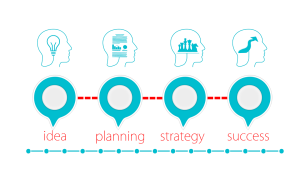Having measurable goals is crucial to be a successful employee. They help you clearly outline what you need to accomplish in your career. When you accomplish a goal, you get an immense amount of satisfaction.
Thus, goals can help contribute to emotional well-being, fulfillment, and many other positive consequences. They could boost their interpersonal skills and help you develop many positive habits while tackling negative behaviors.
When you lack clear goals as an employee, numerous negative consequences can arise. You’re more likely to experience stress, disorganization, and increased anxiety. However, by understanding your innate strengths through assessments like the HIGH5 test, you can set more meaningful and achievable goals. This strengths-based approach not only mitigates these negative effects but also enhances your overall job satisfaction and performance.
However, anyone can receive the benefits of having goals. This article will explain the many benefits of goals and how you can implement them.
What Are Employee Goals? Definition & Meaning
Goals are a list of tasks or objectives that you wish to accomplish by a certain time. Employee goals, specifically, are goals set by employees. They relate to making money, being productive, and so on.
They could relate to overall business goals as well. Typically, if the business wants to increase interactions with customers on social media, employee goals follow.
Such a goal could be “I will interact with 20 potential clients a day on Facebook.” Goals are used in personal and professional circumstances.
Employee goals have to relate to work in some way. A work-related employee goal could focus on productivity and minimizing distractions. A personal-related employee goal could focus on self-care, which will boost workplace engagement.
All goals allow individuals to focus on specific objectives to achieve the desired end result.
Why Are Employee Goals Important & Their Benefits
Employee goals serve a number of crucially important benefits. They help employees understand the tasks they must complete and boost productivity. Additionally, employees can learn many new skills if that is their goal.
They feel more motivated and engaged when there is a specific goal in mind. Because of this, many organizations set a company goal and encourage employees to set individual goals for themselves.
Below, you will find a shortlist of the positive outcomes associated with having employee goals.
10 Benefits of Achieving Employee Goals
- Increased productivity and efficiency in the workplace.
- More communication and an increase in conflict management skills.
- More time is dedicated to the most important tasks at work (and fewer distractions).
- Thoughtful planning and deliberation within the workplace.
- Employees will care more about performance review scores and customer feedback.
- A more positive attitude and the use of a growth mindset. Not dwelling on mistakes.
- An increased desire to be creative and think outside of the box.
- Staying motivated, even when you do not immediately succeed.
- Strong, united company culture and clearly aligned purpose.
- Higher employee retention rates and more engagement.
Examples of Employee Goals and Objectives
There are many ways to set professional goals for employees. There are also many different types of goals employees utilize. In any case, their benefits are clearly measurable and immense.
If you are having a hard time deciding which goals to pursue, the few goals listed below are universally important to employees.
The following are a few examples of employee goals:
Productivity: Getting More Done
Having a productivity goal as an employee encourages you to be a better team player and overall worker. It ensures that you can stay focused and achieve a greater purpose. Having productive employees is also beneficial to entrepreneurs.
The more productive your team is, the more you are able to achieve as an overall organization. Productive individuals ensure that your company does not stagnate. They continue to work so you keep any competitive advantage over the competition.
Productivity goals are also relatively easy to measure. You can use the number of hours worked, items sold, or products produced as a measurement of productivity.
Efficiency: Doing it Faster and Better
Another common type of goal is the efficiency goal. Efficiency is the ability to perform more with fewer resources. When you are efficient, you are also productive.
All the benefits associated with productivity are also included in this goal type. Additionally, being efficient limits the number of expenses you need to utilize. Thus, it will cost the entrepreneur less to hire an efficient employee than an inefficient one.
Being efficient with your time ensures that you get tasks done. It usually also leaves you with more time to do what truly matters, instead of focusing on unimportant tasks.
Education: To Learn New Technical Skills
Out of all the performance goal types, technical skill-related goals are the easiest to measure. However, educational goals also come with a substantial list of benefits.
When you are able to increase your technical knowledge, you can perform more tasks. This could lead to a pay raise and increased average customer satisfaction.
To an entrepreneur, technically skilled employees produce high-quality products. They are able to meet the client’s demands and exceed them. To measure technical skills, employers can use various tools.
You can test the quality of the end product, conduct customer surveys, and compare your product to others in the market.
Personal Development: To Improve Soft Skills & Discover Strengths
Self-discovery is a cornerstone of life satisfaction and effective goal setting. Improving soft skills enhances employee performance across the board, from leadership and productivity to self-confidence and commitment. The HIGH5 strengths assessment offers a powerful tool for this self-discovery process. By identifying your top strengths, you gain insights that can guide your personal development journey, allowing you to focus on areas where you naturally excel. This strengths-based approach not only boosts performance but also increases job satisfaction and engagement, as you align your goals with your innate talents.
However, deciphering your employee’s (or your) soft skills is challenging to do on your own. If you wish to simply and efficiently discover your strengths, consider taking the HIGH5 Test.
You will get a clear and detailed report on the soft skills you possess. Then, you can create goals that are tailored to your abilities and desires.
How To Set and Develop Employee Goals?
When setting goals for your employees, it’s crucial to ensure they are SMART: Specific, Measurable, Attainable, Relevant, and Time-bound. However, to truly optimize goal-setting, consider incorporating a strengths-based approach. By utilizing tools like the HIGH5 strengths assessment, you can align SMART goals with each employee’s unique strengths profile. This combination of SMART criteria and strengths awareness creates goals that are not only well-structured but also personally motivating and naturally achievable for each individual.
By using this type of goal, you can clearly outline a set of tasks they should accomplish to meet them. Think about the contrast between SMART goals and a not-so-smart goal.
The latter will be vague, so employees do not know which tasks to perform. It may also be unrealistic. These problems can be avoided by using the SMART method.
Additionally, you can ask employees about their personal goals to set a more relevant employee goal. If they are personally working on losing weight, you can assume they are working on their discipline.
The same focus on discipline can be applied to the workplace (by creating self-management goals). So, an appropriate goal to suggest to such a person would be dedicating at least the first 3 hours of the day to pure work.
You can see if someone is completing such a goal by using tracking software. You need to ensure the goals you set for employees are aligned with your organizational goals.
After all, the entire team should have a united mission and shared purpose. Inspire your employees to take your organizational goals seriously. Then, tailor these goals to each employee if possible.
Combine their personal goals with your goals as the employer to great the perfect goal.
Pro Tip From HIGH5
When setting team goals, consider the collective strengths profile of your team. Use the HIGH5 team assessment to identify complementary strengths among team members. Assign roles and responsibilities that align with each person’s top strengths to maximize overall team performance and engagement.
How to Measure Employee Performance and Goals?
Measuring employee targets is essential to gauge dedication and progress. While traditional productivity metrics are valuable, a more comprehensive approach involves understanding and leveraging each employee’s strengths. The HIGH5 strengths assessment provides insights into an individual’s natural talents, allowing for more nuanced and personalized performance evaluation. By aligning performance metrics with an employee’s strengths profile, you can create a more accurate and motivating measurement system that encourages growth in areas where employees are most likely to excel.
For instance, you can keep track of how many sales an individual makes, of how many items they produce on the line.
You can also measure how many hours they spend on the phone or how many projects they finish monthly. To determine the quality of work, look to your customers.
Seek out their opinion on your products. If they speak highly of them, you can assume your employees are meeting your goals. Measure customer levels of satisfaction through surveys.
Understanding your competition’s product could also help you evaluate whether employees are achieving their goals. If you lose a competitive advantage, this is a sign of employees overlooking goals.
Another way to measure goal following is to directly ask employees. If you have an honest relationship with your staff, they will likely not have a problem with telling you if they are meeting goals.
Pro Tip From HIGH5
Incorporate strengths-based metrics in your performance evaluations. Alongside traditional KPIs, assess how effectively employees are utilizing their top HIGH5 strengths in their roles. This approach not only measures performance but also encourages continuous personal development and job crafting.
How to Improve Employee Goals?
The goals you set for staff should be changed often. They are dependent on your staff’s productivity, emotional status, and your business’s place in the market. Stay aware of all of these elements.
When one of them changes, it is likely time to change and improve a goal. In general, the best way to improve any goal is to make it more specific and relevant to each employee.
For instance, saying “you need to be more productive” is quite vague. You can improve this goal by adding a time and specific metric to it: “call at least 20 customers by Tuesday.” Tailor each of your goals to individual employees (if possible).
Goals will mean more to employees if they are relevant to their passions and idea of success. If you currently set blanket goals that apply to everyone, individualize them.
Ask the individual about their plans in the future and find which goals help them contribute to your business and achieve their idea of success.
How To Create Your Own Employee Worksheet?
An employee worksheet helps you outline the tasks staff members should perform. They turn intangible goals into manageable tasks. To ensure that you do not overwhelm employees, make each step clear.
Tell them to focus on one at a time and discourage multitasking. To create your own employee worksheet, you will need typing software. Consider using Word or Docs.
Create a shortlist of goals you would like the employee to perform. Under them, list a few tasks that will help accomplish the outlined goals. Employee worksheets are useful.
They remind individuals about goals and ensure they stay focused. However, it is also time-consuming to produce them. You could benefit from using a few universal, organizational goals in combination with your individualized goals.
Once you have this list created, you can print the paper out and give it to employees. Or, you can send it to them via email.
How To Create own Employee Template?
Employee templates and employee worksheets are utilized in similar manners. They both remind employees of goals and tasks. However, a template is more general.
The benefit of utilizing them is the additional creativity and individualization. Employees can create their own task lists that match the goals you outline.
To create a template, simply make a list of organizational goals employees should achieve. Leave a few spots blank so employees can add their individual goals.
Do not list specific tasks. Instead, direct employees to think about these tasks themselves. You can distribute these templates via email or print handouts.
Frequently Asked Questions About Employee Goals
What should I write for employee goals?
Employee goals should be dependent on your organizational goals and the goals of the individual. Ask your employee: what do you want to achieve in your career? Who do you care about helping, and why?
This will help you determine their motivations and passions. Then, understand the overall goal for your company. Once you have these two elements understood, consider what the employee is currently not performing well in.
This is the region where the individual has the most growth opportunity. Center your goals around this issue. So, when you write employee goals, take these factors into account.
What are performance goals examples?
Goals will vary from company to company and individual to individual. However, a few goals are applicable to nearly all industries and staff members.
One could be a productivity goal. This could be “call 20 people a day” or “generate $200 in sales every day.” Other goals focus on customer satisfaction.
You could say: “receive 95% positive feedback on your report to customers.” Take communication, dedication, and positivity into account, too.
Possible goals could include: arriving to work 15 minutes early every day, informing all team members when starting a new project, and keeping communication open when projects begin.







